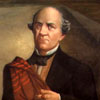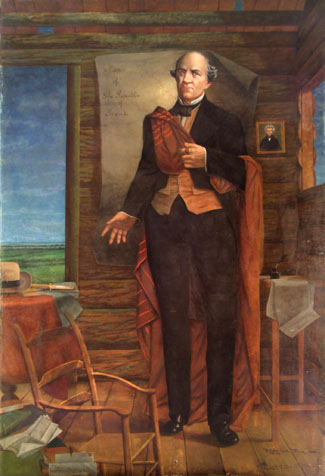Sam Houston portrait returns to SMU after decades-long journey
Repaired and reframed, a rare 1902 full-length portrait of Texas's most famous military leader and statesman returns to SMU.

In 1929, a full-length portrait of Texas military leader and statesman Sam Houston, painted in 1902 by Henry Arthur McArdle, was donated to SMU by Texas merchant and historian James T. DeShields.
 Portrait of Sam Houston, which will be formally dedicated March 1. |
Eighty years later, the portrait is returning to campus after a long journey that took it from SMU’s A.V. Lane Museum to a Dallas Fair Park attic back to SMU’s Bridwell Library and, most recently, to a Dallas art conservation lab.
Repaired and reframed thanks to the support of multiple donors, the 95- by-66-inch oil on canvas will be hung in the Texana Room at DeGolyer Library. The portrait shows Houston in a wooden shed that opens presumably onto a view of the San Jacinto plain. He is wearing a woolen serape and suit. Surrounding him are a Republic of Texas map, a portrait of President Andrew Jackson, books and letters from Jackson and a copy of his "Treaty with Indians."
DeGolyer also holds DeShields’ personal papers, which were donated by his daughter and SMU alum Venora Arthur (’30).
“The Texana Room is an especially appropriate home for a portrait of a leading Texas historical figure by a pioneering Texas artist,” says Sam Ratcliffe, head of Bywaters Special Collections at the Hamon Arts Library. McArdle (1836- 1908) of San Antonio is known for his sweeping battle scenes of the Alamo and San Jacinto that hang in the Texas Capitol in Austin.
Ratcliffe rediscovered the Sam Houston portrait more than 15 years ago while conducting research on DeShields, a collector of Texas art and letters. Dallas historian Michael Hazel (’70), member of the Libraries Executive Board and Friends of the SMU Libraries, had alerted Ratcliffe to a painting in storage at the Automobile Building at Fair Park.
“We climbed into a hot, dark attic,” Ratcliffe recalls, “and I nearly fainted when I saw this huge portrait on the floor with McArdle’s signature and the subscript ‘For Jas. T. DeShields.’ ”
Further research revealed another surprise: a 1941 agreement signed by SMU President Umphrey Lee and history Professor Herbert P. Gambrell to loan the portrait for five years to the Dallas Historical Society from the University’s A.V. Lane Museum, formerly housed in old Kirby Hall.
In 1996, 55 years later, the painting was returned to SMU and rejoined the Lane materials, which today are part of Bridwell Library’s archives.
Showing signs of damage and deterioration, the portrait might have remained hidden from the public, Ratcliffe says, were it not for the efforts of art collector and Libraries Executive Board and Friends member Dorothy Garland (’46).
“It took my breath away that SMU had this magnificent work by McArdle,” says Garland, who learned about the painting several years ago during the Friends’ Tables of Content dinner. “Very few exist – there’s not another that I know of north of Baylor University in Waco.” McArdle had taught art for many years at Baylor Female College.
A committee was formed to select a conservator and framer and to raise funds for the painting’s repair. Members included Garland and Ratcliffe, along with Russell Martin, DeGolyer Library director; James McMillin, Bridwell Library associate director; Jon Speck, director of facilities and exhibit designer at Bridwell; and Mark Roglán, Meadows Museum director.
Gifts and grants from Frost Bank, Thompson & Knight LLP, Texas Commission on the Arts, the Texas Historical Foundation, Friends of the SMU Libra - ries and more than 60 individual donors funded the painting’s repair this year by Dallas conservator Helen Houp. Over several months in her lab, her work on the canvas included cleaning years of grime and dust, securing paint that had suffered water damage and filling a hole and scrapes.
“This painting has been in hiding,” Houp says, “and it’s wonderful that we can resurrect it.”
Garland agrees. “This portrait is a treasure that needs to be hung where the public can see it,” she says.
# # #